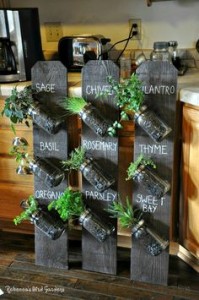One of the great things about gardening is that it is can serve as platform to explore a seemingly endless line of creative possibilities. Well, all of these prospects still relate to growing plants for various purposes, but within that context there are an incredible number of options to explore. Moreover, each year brings with it a new set of seasons and ideas to explore as well, with newcomers and veterans alike introducing some new planter model or perhaps a special chemical / method they’ve used to cultivate some prize-winning produce. What we’re about to take a look at are the hot current trends for gardening in 2014, specifically – what people seem to be the most interested in right now…
Indoor and “city” gardening
 For the most part, when people think of gardening they tend to envision areas outside metropolitan zones, perhaps in the remote countryside or in sprawling suburbs, where people in straw hats slam spades into the ground and till the soil with gas-powered machines. The truth is, more and more people who have always lived in cities are turning toward gardening and there are a number of reasons as to why this is the case. Likewise, this tends to go hand in hand with indoor gardening as well, where people actually grow lots of plants inside their home or apartment (which is quick and easy to pull off if you know what you’re doing).
For the most part, when people think of gardening they tend to envision areas outside metropolitan zones, perhaps in the remote countryside or in sprawling suburbs, where people in straw hats slam spades into the ground and till the soil with gas-powered machines. The truth is, more and more people who have always lived in cities are turning toward gardening and there are a number of reasons as to why this is the case. Likewise, this tends to go hand in hand with indoor gardening as well, where people actually grow lots of plants inside their home or apartment (which is quick and easy to pull off if you know what you’re doing).
First off, lots of individuals tend to invest in specific planters and implements which are conducive to using indoors. …Beyond that, you really only need a great place to keep your plants (and of course a means of maintaining a schedule which allows you to care for them). Typical installations might include miniature herb gardens, lots of house plants (great for air purification reasons), seasonal flowers (which can also be bundled and sold if you know what you’re doing), as well as edible crops. Where herbs are concerned, offerings such as basil, parsley, lemon-grass or rosemary are typical. Basically, you want to cultivate those plants which you might actually use in your own cooking, for example. This really only takes a bit of forward-thinking planning and in virtually no time at all you have fresh ingredients to use, which also remains impressive to visitors and dinner guests.
 Seasonal flowers can be a great source of joy too, especially when it comes to growing them indoors, offering a fragrant and colourful addition to accentuate your home’s interior. One of the benefits here is that you can easily transport large quantities in the form of seeds or sprouts which later will bloom into stunning visual spectacles. More info about seeds, native plants and wildflowers available at www.florabank.com.au. Great choices in this domain include:
Seasonal flowers can be a great source of joy too, especially when it comes to growing them indoors, offering a fragrant and colourful addition to accentuate your home’s interior. One of the benefits here is that you can easily transport large quantities in the form of seeds or sprouts which later will bloom into stunning visual spectacles. More info about seeds, native plants and wildflowers available at www.florabank.com.au. Great choices in this domain include:
- Hibiscus
- African Violet
- Flowering Maple
- Jasmine
- Calamondin Orange
- Gloxinia
- Geraniums
- Begonias
- Native Plants
- And many, many more…
Then there’s the possibility of growing actual edible crops inside. Naturally, this can be touch to pull off unless you have the right space and tools to do it (the correct kinds of planters, lighting, and a large room or rooftop area for growing). Lots of people opt to grow specific types of veggies and fruits inside, but take note that many of them (like those we’re about to look at) require soil that drains (or a system which facilitates this). In essence, this means stones in the bottom of a pot or a specific type of planter which allows for better drainage. Anyway, look to grow carrots, scallions, mushrooms, avocados, lemons, micro greens, salad greens, tomatoes, and other things indoors if you can.
 Arguably, the most popular gardening trend out there right now is that of the vertical installation, aka the “vertical garden”. One of the great things about this method is that you can place them in increasingly smaller spaces because they’re taller than they are wide, obviously. However, perhaps the coolest thing about them is that they just look incredibly cool and organized. You can place one on a back porch or outside deck and take care of your watering / cultivation concerns very easily, all in one swoop. Moreover, because you can utilize various designs, some can even be made slightly portable, assuming that you would need to move it, that is. Typically speaking, most people elect to use a vertical garden type for kitchen herbs, which again, works great for those who live in the city as well.
Arguably, the most popular gardening trend out there right now is that of the vertical installation, aka the “vertical garden”. One of the great things about this method is that you can place them in increasingly smaller spaces because they’re taller than they are wide, obviously. However, perhaps the coolest thing about them is that they just look incredibly cool and organized. You can place one on a back porch or outside deck and take care of your watering / cultivation concerns very easily, all in one swoop. Moreover, because you can utilize various designs, some can even be made slightly portable, assuming that you would need to move it, that is. Typically speaking, most people elect to use a vertical garden type for kitchen herbs, which again, works great for those who live in the city as well.
“Second-hand” gardens
Another popular option is the “second-hand” garden, or a group of crops / plants which you cultivate from those of a friend or neighbour. Who says you have to actually go out and spend money on seeds, planters and other things, eh? You can actually just learn how to plant and grow seeds from items collected nearby and even create your own planters with collected items, including discarded cans, plastic containers and refuse. Sure, it might be a bit on the cheap side, but in all honesty a carefully-prepared garden set-up will work amazingly; it all depends on your ingenuity and imagination in the end. You can even tie together the two concepts above if you want, creating a city / indoor vertical garden that’s been constructed from old 2-litre soda bottles, utilizing smooth stones in the bottom of each along with freshly collected soil. You would cut off the bottoms of the bottles and use the spouts as drainage holes, etc. Some people have even published extensive online guides showing you how to easily create amazing irrigation systems.
Substantial produce gardens
Finally, we come to substantial produce gardens – which are designed to yield fairly large amounts of vegetables year in / year out. Naturally, growing this type of garden isn’t exactly easy and requires more extensive knowledge, land as well as increased care and perhaps investment. However, once you get the hang of it you’ll be able to become infinitely more self-sustaining. Some people even manage to create backyard gardens of this type which allow them to can or preserve their crops for the winter months.